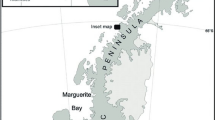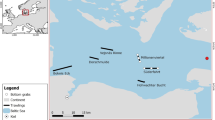Abstract
Selection of methods for quantitative description and assessment of food habits is a concern for trophic investigations. We used diet data for largemouth bass Micropterus salmoides, to compare a caloric-based approach with eight diet indices: percent frequency of occurrence, percent total number, percent total weight, mean relative number, mean relative volume, relative importance index, prey-importance index, and mean stomach fullness. Mean caloric contribution of stomach contents for each prey taxon was used as a standard to compare diet indices. Temporal differences in composition and caloric contents of largemouth bass stomach contents were apparent. Most diet indices provided similar assessments when diets were dominated by a single prey type (i.e., gizzard shad during June-October). However, diet indices evaluated provided dissimilar assessments of stomach contents when a variety of prey with differing caloric densities were consumed (e.g., April). Mean stomach fullness and percent by volume were significantly (p < 0.002) correlated (r = 0.94 − 1.00) with mean caloric contribution of largemouth bass stomach contents during all months. Unlike percent by weight, mean stomach fullness accounted for differences in fish size and stomach capacity. Thus, mean stomach fullness by prey type appears to be the most appropriate index when objectives include simplified caloric-based assessments of fish diets.
Similar content being viewed by others
References
Adams, S. M. & J. E. Breck. 1990. Bioenergetics. pp. 389–415. In: C.B. Schreck & P.B. Moyle (ed.), Methods for Fish Biology, American Fisheries Society, Bethesda.
Adams, S. M., R. B. McLean & M. M. Huffman. 1982a. Structuring of a predator population through temperature-mediated effects on prey availability. Can. J. Fish. Aquat. Sci. 39: 1175–1184.
Adams, S. M., R. B. McLean & J. A. Parrotta. 1982b. Energy partitioning in largemouth bass under conditions of seasonally fluctuating prey availability. Trans. Amer. Fish. Soc. 111: 549–558.
Allen, J. R. M. & R. J. Wootton. 1982. The effect of ration and temperature on the growth of the three-spined stickleback, Gasterosteus aculeatus L. J. Fish Biol. 20: 409–422.
Anderson, R. O. & R. M. Neumann. 1996. Length, weight, and associated structural indices. pp. 447–482. In: B. R. Murphy & D.W. Willis (ed.), Fisheries Techniques, 2nd edition, American Fisheries Society, Bethesda.
Bennett, D. H. & J. W. Gibbons. 1972. Food of largemouth bass (Micropterus salmoides) from a South Carolina reservoir receiving heated effluent. Trans. Amer. Fish. Soc. 101: 650–654.
Berg, J. 1979. Discussion of methods of investigating the food of fishes, with reference to a preliminary study of the prey of Gobiusculus flavescens (Gobiidae). Marine Biology 50: 263–273.
Bowen, S. H. 1996. Quantitative description of the diet. pp. 513–532. In: B. R. Murphy & D. W. Willis (ed.), Fisheries Techniques, 2nd edition, American Fisheries Society, Bethesda.
Bowen, S. H., E. V. Lutz & M. O. Ahlgren. 1995. Dietary protein and energy as determinants of food quality: trophic strategies compared. Ecology 76: 899–907.
Brett, J. R. & T. D. D. Groves. 1979. Physiological energetics. pp. 279–352. In: W. S. Hoar, D. J. Randall & J. R. Brett (ed.), Fish Physiology, volume 8, Academic Press, New York.
Bryan, S. D., T. D. Hill, S. T. Lynott & W. G. Duffy. 1995. The influence of changingwater levels and temperatures on the food habits of walleye in Lake Oahe, South Dakota. J. Freshwater Ecol. 10: 1–10.
Bryan, S. D., C. A. Soupir, W. G. Duffy & C. E. Freiburger. 1996. Caloric densities of three predatory fishes and their prey in Lake Oahe, South Dakota. J. Freshwater Ecol. 11: 153–161.
Cailteux, R. L., W. F. Porak & S. Crawford. 1990. Reevaluating the use of acrylic tubes for collection of largemouth bass stomach contents. Proc. Annu. Conf. Southeast. Assoc. Fish and Wildl. Agencies 44: 126–132.
Cochran, P. A. & I. R. Adelman. 1982. Seasonal aspects of daily ration and diet of largemouth bass, Micropterus salmoides, with an evaluation of gastric evacuation rates. Env. Biol. Fish. 7: 265–275.
Cummins, K.W. & J. C. Wuycheck. 1971. Caloric equivalents for investigations in ecological energetics. Mitt. int. Ver. Limnol. 18: 1–158.
Gannon, J. E. 1976. The effects of differential digestion rates of zooplankton by alewife, Alosa pseudoharengus, on determinations of selective feeding. Trans. Amer. Fish. Soc. 105: 89–95.
George, E. L. & W. F. Hadley. 1979. Food and habitat partitioning between rock bass (Ambloplites rupestris) and smallmouth bass (Micropterus dolomieui) young of the year. Trans. Amer. Fish. Soc. 108: 253–261.
Healey, M. C. 1972. Bioenergetics of the sand goby (Gobius minutus) population. J. Fish. Res. Board Can. 29: 187–194.
Hellawell, J. M. 1971. The autoecology of chub, Squalis sephalus (L.) of the River Lugg and Afon Llynfi. III. Diet and feeding habits. Freshwater Biology 1: 369–387.
Hellawell, J. M. 1972. The growth, reproduction and food of the roach, Rutilus rutilus (L.) of the River Lugg, Herefordshire. J. Fish Biol. 4: 469–486.
Hodgson, J. R. & J. F. Kitchell. 1987. Opportunistic foraging by largemouth bass (Micropterus salmoides). Amer. Mid. Nat. 118: 323–336.
Hyslop, E. J. 1980. Stomach contents analysis- a review of methods and their application. J. Fish Biol. 17: 411–429.
Jackson, J. J., D. W. Willis & D. G. Fielder. 1992. Food habits of young-of-the-year walleyes in Okobojo Bay of Lake Oahe, South Dakota. J. Freshwater Ecol. 7: 329–341.
Kelso, J. R. M. 1973. Seasonal energy changes in walleye and their diet in West Blue Lake, Manitoba. Trans. Amer. Fish. Soc. 102: 363–368.
Kerr, S. R. 1971. Prediction of fish growth efficiency in nature. J. Fish. Res. Board Can. 28: 809–814.
Kimball, D. C. & W. T. Helm. 1971. A method of estimating fish stomach capacity. Trans. Amer. Fish. Soc. 100: 572–575.
Kitchell, J. F. & J. E. Breck. 1980. Bioenergetics model and foraging hypothesis for sea lamprey (Petromyzon marinus). Can. J. Fish. Aquat. Sci. 37: 2159–2168.
Knight, R. L. & F. J. Margraf. 1982. Estimating stomach fullness in fishes. North Amer. J. Fish. Manage. 2: 413–414.
Lampert, W. & U. Sommer. 1997. Limnoecology: the ecology of lakes and streams. Oxford University Press, New York. 382 pp.
Magnuson, J. J. 1969. Digestion and food consumption by skipjack tuna (Katsuwonus pelamis). Trans. Amer. Fish. Soc. 98: 379–392.
Markus, H. C. 1932. The extent to which temperature changes influence food consumption in largemouth bass (Huro floridana). Trans. Amer. Fish. Soc. 62: 202–210.
Michaletz, P. H. 1997. Influence of abundance and size of age-0 gizzard shad on predator diets, diet overlap, and growth. Trans. Amer. Fish. Soc. 126: 101–111.
Miller, R. G., Jr. 1981. Simultaneous statistical inference, 2nd edition. Springer-Verlag, New York. 299 pp.
Miranda, L. E. & R. J. Muncy. 1989. Bioenergetic values of shads and sunfishes as prey for largemouth bass. Proc. Annu. Conf. Southeast Assoc. Fish Wildl. Agencies 43: 153–163.
Paloheimo, J. E. & L. M. Dickie. 1966. Food and growth of fishes. III. Relationships among food, body size, and growth efficiency. J. Fish. Res. Board Can. 23: 1209–1248.
Perry, W. B., W. A. Janowsky & F. J. Margraf. 1995. A bioenergetics simulation of the potential effects of angler harvest on growth of largemouth bass in a catch-and-release fishery. North Amer. J. Fish. Manage. 15: 705–712.
Pinkas, L., M. S. Oliphant & I. L. K. Iverson. 1971. Food habits of albacore, bluefin tuna and bonito in California waters. California Fish and Game 152: 1–105.
Probst, W. E., C. F. Rabeni, W. G. Covington & R. E. Marteney. 1984. Resource use by stream-dwelling rock bass and smallmouth bass. Trans. Amer. Fish. Soc. 113: 283–294.
Rice, W. R. 1989. Analyzing tables of statistical tests. Evolution 43: 223–225.
Rice, J. A. & P. A. Cochran. 1984. Independent evaluation of a bioenergetics model for largemouth bas. Ecology 65: 732–739.
Seaburg, K. G. & J. B. Moyle. 1964. Feeding habits, digestive rates, and growth of some Minnesota warmwater fishes. Trans. Amer. Fish. Soc. 93: 269–285.
Smagula, C. M. & I. R. Adelman. 1982. Day-to-day variation in food consumption by largemouth bass. Trans. Amer. Fish. Soc. 111: 543–548.
Stewart, D. J., J. F. Kitchell & L. B. Crowder. 1981. Forage fishes and their salmonid predators in Lake Michigan. Trans. Amer. Fish. Soc. 110: 751–763.
Stewart, D. J., D. Weininger, D. V. Rottiers & T. A. Edsall. 1983. An energetics model for lake trout, Salvelinus namaycush: application to the Lake Michigan population. Can. J. Fish. Aquat. Sci. 40: 681–698.
Strange, R. J. & J. C. Pelton. 1987. Nutrient content of clupeid forage fishes. Trans. Amer. Fish. Soc. 116: 60–66.
Swedberg, D. V. & C. H. Walburg. 1970. Spawning and early life history of the freshwater drum in Lewis and Clark Lake, Missouri River. Trans. Amer. Fish. Soc. 99: 560–570.
Van Den Avyle, M. J. & J. E. Roussel. 1980. Evaluation of a simple method for removing food items from live black bass. The Progressive Fish-Culturist 42: 222–223.
Wallace, R. K., Jr. 1981. An assessment of diet-overlap indexes. Trans. Amer. Fish. Soc. 110: 72–76.
Ware, D. M. 1975. Growth, metabolism, and optimal swimming speed of a pelagic fish. J. Fish. Res. Board Can. 32: 33–41.
Warren, C. E. & G. E. Davis. 1967. Laboratory studies on the feeding, bioenergetics, and growth of fish. pp. 175–214. In: S. D. Gerking (ed.), The Biological Basis of Freshwater Fish Production, Blackwell Scientific Publications, Oxford.
Williams, W. E. 1959. Food conversion and growth rates for largemouth bass and smallmouth bass in laboratory aquaria. Trans. Amer. Fish. Soc. 88: 125–127.
Windell, J. T. 1971. Food analysis and rate of digestion. pp. 215–226. In: W. E. Ricker (ed.), Methods for Assessment of Fish Production in Fresh Waters, International Biological Programme Handbook 3, Blackwell, Oxford.
Wright, L. D. 1970. Forage size preference of the largemouth bass. The Progressive Fish-Culturist 32: 39–42.
Author information
Authors and Affiliations
Rights and permissions
About this article
Cite this article
Pope, K.L., Brown, M.L., Duffy, W.G. et al. A Caloric-based Evaluation of Diet Indices for Largemouth Bass. Environmental Biology of Fishes 61, 329–339 (2001). https://doi.org/10.1023/A:1011096819147
Issue Date:
DOI: https://doi.org/10.1023/A:1011096819147




